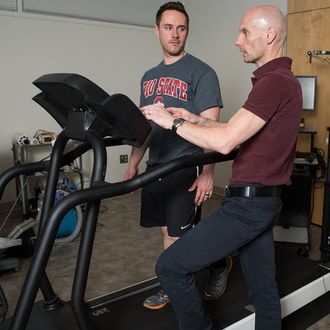
For most runners who live in colder climates, or in places where running outside isn’t feasible, treadmills are seen as a necessary evil, a way to get their miles in that is far from ideal. Some runners don’t think treadmill-running is an accurate simulation of the “real thing” (though these fears are probably a bit overblown); most simply think treadmill running is horribly boring.
According to Dr. Steven Devor of Ohio State University, that’s because when you run outside, “You are constantly speeding up or slowing down without realizing it.” On a treadmill, on the other hand, “It’s this nonstop, constant, no-variance thing” — a recipe for drudgery. That’s why he and a colleague, Cory Scheadler of Northern Kentucky University, have developed a prototype of a new treadmill that they say automatically adjusts its pace to match its user’s, and have published some early results based on trials by endurance runners in a new paper in Medicine & Science in Sports and Exercise.
The treadmill uses a sonar device mounted behind the runner to bounce a signal off the runner and determine where they are on the belt. If they’re close to the front, the speed of the belt is increased; if they’re lagging, it drops. Devor said speed transition is “seamless.” “It’s honestly really, really cool,” he said. (I asked him whether there was any video available of the treadmill in action, but he said there wasn’t.)
Devor’s prototype is sitting in his lab, and he said that he and Scheadler are just about ready to set out on the long process of commercializing their device. Assuming the treadmill works as smoothly as Devor says it does, its store-ready descendants could provide some welcome relief from the winter-running doldrums.




